Cross-posted on the TL Advisors Blog
Last week I was extremely fortunate to attend the ASB Unplugged Conference in Mumbai, India at the American School of Bombay, with my lovely colleagues, Chrissy Hellyer, Heather Vlach, Dana Watts and Jean Williams. Not only was Mumbai absolutely amazing in every way, but the conference was a treasure-trove of ideas, inspiration and advice for teachers and administrators in 1:1 schools (or those planning to go 1:1).
Here are the top 5 things that really jumped out at me during the conference:
1. Involve all stakeholders
Every single presenter in every single session I attended, from Bruce Dixon to Scott McLeod, to Alex Inman, highlighted the absolutely critical importance of involving all community members in the planning and decision-making processes involved in going 1:1. In addition, it was crystal clear that ASB had done just that, with engaging sessions offered by both parents and students, and with almost every staff member I met being not only a teacher or administrator, but also a member of the Technology Committee.
As Alex pointed out during his session, “When people feel like they’re part of a process, if they feel heard and like they’re generally listened to, that’s how you get buy-in.” He laid out a clear (and well-tested) process for bringing in all voices as schools make the transition:
Step 1: Determine your goal:
Not just to have a 1:1 program – what exactly are you hoping to see?
Step 2: Create focus groups of major constituents:
- Provide a safe space (don’t put teachers and supervising admin in the same group)
- Aim to ask the groups only 4 essential questions, so there’s enough time to discuss them (have outside consultants asking the questions)
- Take the discussion from the focus group and create a “language” for the goals, and rewrite the goals taking into account what you’ve learned, called consensus goals
Step 3: Build survey based on responses
- Include positive and negative concerns. Including concerns in the survey gives voice to the grouchy people, and then gathers some buy-in from them, and you find out if you’ve a) dismissed that person too quickly, or b) it really is only that one or two people who have negative concerns.
- Think long-term, but be certain to deal with the short term as well.
- Do this with the purpose of creating an assessment too, shows that you’ve listened – not just asked for feedback and done nothing with it. It’s very important to use the language the focus group has used – otherwise it’s hard for the focus group to tell that their concerns were heard.
Designing the Survey: (put the following items in the survey)
- Demographics: Need to be able to sort the survey, make sure to ask the right questions (from the focus group, look at where you saw differences in the responses, and make sure you add that option to your survey)
- Value & appreciation of 21st century skills – attitudes and values that you care about need to stem from the mission statement
- Personal Technology Literacy
- Professional Practices: practical applications of pedagogy and technology
- Perceived benefits and concerns of going 1:1
- Professional learning networks (who or what is their PLN)?
- If your questions are framed within the values and mission of your school, then when you get them talking about 1:1 they’re already thinking about the values and mission of your school
Step 4: Analyzing the results:
- Keep an open mind – if you don’t regularly seek feedback from people, the first time they take a survey (esp if it’s anonymous), they will dump on you – it’s cathartic, they’ve been waiting (do the survey before the deployment, then half way through, then the end of the year. after the first year, just do it once a year)
- Review by committee – don’t look at your data in a vacuum & publish that data
- Strongly consider getting objective third party help
The 21 Steps to 21st Century Learning from the Anytime Anywhere Learning Foundation also outlines a very clear process for involving all stakeholders and successfully implementing a 1:1 program from planning, to preparation, to implementation, to review.
2. School leadership must take an active role in the process of implementing 1:1
Both Bruce Dixon’s pre-conference and Scott McLeod’s Leadership Institute highlighted the importance of any 1:1 initiative (well, any school initiative, really) being actively led by school administrators. Bringing in a 1:1 program is not something that impacts just one grade level or one group of students and teachers. Regardless of how it starts in a school, it is something that will change school culture, school community, and school operations.
The school must have an administrator who not only champions the concept, but who also can promote it within the school community, who understands the change it will bring, and who will wholeheartedly support the teachers, students and parents who will undoubtedly be affected by this new learning environment.
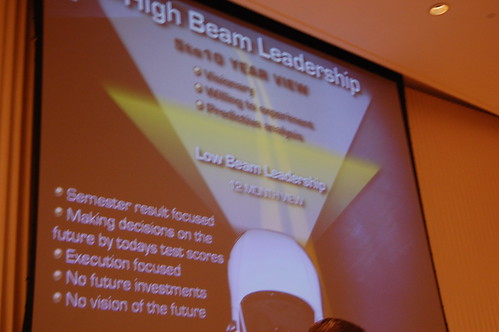
Scott Klososky and Paul Fochtman (the Superintendent of ASB) presented a joint session on the concept of High Beam Leadership – using data to analyze and predict the future so that you’re making decisions with a 10-year view. They highlighted high beam leadership as critical, especially in the area of technology, and that for school leaders to get an accurate perspective on the future, they need to be in control of the “river of information” streaming into their lives. School leaders must be actively aware of the changes technology is bringing to society to be able to successfully plan with a long term vision for their school. Understanding and utilizing the power of tools like RSS, Twitter, and blogging to stay up-to-date is now a requirement.

According to Scott and Paul, school leadership should also be willing to take some chances. Schools have a tendency to “wait and see” what happens when other schools implement new initiatives, for example 1:1. Unfortunately the “wait and see” method means that you’re relying on the herd and essentially letting others make decisions for you. A critical skill highlighted with the High Beam concept is the ability to take control of all the information that’s available and to make your own decisions. If you’re just following what others are doing, you’re not really planning for the future.
3. Our schools are great at buying “things.”
During Scott McLeod’s session, in a room full of international school administrators (and their tech teams), we took a quick survey based on the ISTE Standards for Administrators. Sadly, the results of the survey were pretty obvious:
Clearly, it’s easy for our well-funded schools to buy hardware, but it’s not so easy to develop and articulate a clear vision for what to do with those tools, or to implement long-term, effective professional development in order to make the most of the things we bought, and many of our school leaders prefer a more “hands off – let the tech team take care of tech” approach, rather than a true understanding of what this hardware should be creating in our schools.
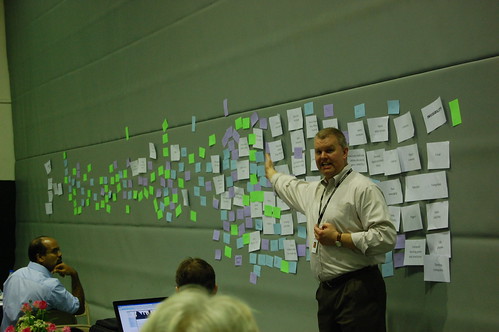
Scott talked a lot about the changes our economy has gone through in recent years and what that will mean for the future (and our students). “Every single information-oriented segment of society is being dramatically impacted by the information revolution in society. Including schools.” Scott emphasized the need to understand that this impact is going to continue to grow and that more and more industries will be replaced either by technology tools directly, or what technology can enable us to do (for example: travel agents are no longer needed because people can book flights and hotels online). For a more detailed explanation, I highly recommend Scott’s 2008 K12Online presentation about the book Disrupting Class by Clayton Christensen.
Scott also talked about the importance of scaleability – being able to take an initiative from one grade level (say a 1:1 pilot) and being able to scale it to all grade levels at the school:
4. Project Based Learning is where it’s at!
One of the highlights of the conference for me was visiting the Flat Classroom Workshop strand, which ran parallel to the formal conference. Watching students and teachers collaborate on an authentic challenge, collaborating to solve a problem, sharing creative solutions and being able to explain their ideas to outside observers is what I wish I was seeing and doing in school every day. It is the dream educational experience. I’ve already raved about it from the 21st Century Learning Conference in September, but it was great to see it in action again.
Andrew Churches’s Project Based Learning Institute also highlighted the power of designing authentic projects. Although he used a model created by Ted McCain (the 4Ds), I was so pleased to see many obvious parallels to the MYP Technology Design Cycle:
Allowing students to collaborate and create and lead themselves in their own learning is where we need to be heading, but it seems to need a specific infrastructure or expectation in schools. I see it happening regularly in MYP schools, so perhaps that is an essential element to successfully implementing this kind of learning experiences on a school-wide level. As Scott McLeod said during his session, “what we remember best/most is what we attach meaning to. It’s very hard to attach meaning to decontextualized facts.” Project Based Learning ensures that learning is contextualized from start to finish.
5. It’s the little things that make a difference
From the student- and parent-led sessions, I saw so many great tips and ideas for successfully implementing a 1:1 program with the whole school community:
From the students:
- 1:1 is an advantage b/c: “Teachers don’t need to be a source of raw information anymore & they can finally actually teach”
- “Computers automate the tedious processes & give us time to focus on the more creative and processes”
- Students are not ready to go paperless, yet. They like the tactile experience and no boot-up time of working with paper and pencil when relevant.
- Students say: how we engage with info has changed very little in our 1:1 prog. The change = fewer unnecessary mundane steps.
- “Becoming a laptop school streamlines communication between all members of the community”
- School supports the use of an ASB Student Council Facebook fan page as an easy way to communicate exciting news and events with students at school.
- “It’s always possible to get distracted – the tech office can try to block things for a little while, but we always find a way. In the real world, there are always distractions, having a laptop teaches you how to be productive in that environment”
- “Putting things on youtube makes it more fun. Videos you do for Spanish projects can become a viral video in the school”
- “At the end of the day, it makes more sense to have 1 place for all online class communication”
- Advice from students: Ask students what they like when exploring with new tech tools, don’t force tech where it doesn’t fit – choose the right tool for the task.
- “Anytime we get the blue screen of death, we’re allowed to get up and run to the IT office.”
From the parents:
- It’s absolutely critical to get all stakeholders engaged.
Evolution of the program:
- The school portal is important to keep lines of communication open, included is: the online gradebook, a parent Ning, the eLibrary.
- School management systems is not about control, it’s about building a new relationship with your child.
- Training programs for parents create less resistance to change
- Open door policy for tech support – the key element of success
- Each year, more parents become actively engaged
Challenges:
- Learning curve: parents need to be ready to go from day one with distance learning, sign-ups, communication w/teachers, navigating the portal. The tech team now offers a tech orientation for parents to show the portal and the Ning before the first day of school.
- When some families first arrive in a new country and spend their first few months in a hotel, limited access to technology makes it hard to be part of the school community because it’s so technology dependent. The tech team now sends info to parents about tech requirements for the home so parents know what to get when they arrive.
- Tech Knowledge: parents can get overwhelmed (some don’t want to improve their skills), need for parents to acquire school language, students teach parents.
- Understanding school expectations: setting up routines, knowing when to ask for help, decoding intention behind alerts and messages (harder to do in online communication).
- “The kids are learning so much, but the parents get left behind. I don’t know how much the parents realize that.”
- “Paper mentality is pretty much out the door here”
The big positives:
- Extreme amount of information available: access to their assignments, ongoing grades, signing them up for extracurricular activities, notification when they’re sick & go to the nurse, order children’s cafeteria lunches.
- Students really take responsibility for their laptop through the Eggcellent Project: Each student is given a drained egg to take care of for two weeks, along with a special case. If anything happens to the egg, they have to go to the tech office to sign an insurance form.
- Exposure to positive web-based applications to support student learning
- MAP assessment provides specific and detailed information about student progress
- Engagement with students around schoolwork and student performance: real-time access, real-time feedback
- “Using technology helped my child express his thoughts. He will engage with technology because it’s fun.”
- “After the last few years in a 1:1 program here at ASB, I will be looking for a similar school whenever we move on.”
Final Thoughts
Even if your school is not considering a 1:1 program, all of these insights are relevant to any new initiative, especially those related to technology. Of course, this isn’t all that we learned, discussed and reflected on at the conference, and you can find more along those lines within the #asbup2010 tag on Twitter.
It really was interesting to see how consistent this advice was, from every presenter in every session, to casual conversations with other conference participants. Clearly there are many lessons to be learned here, and although each school is different, the fact that these big ideas were highlighted repeatedly makes them even more credible in my mind. As ISB is about to embark on our own 1:1 initiative, and my new school YIS will be doing the same after I arrive, this is all especially relevant to me right now, so I would love some advice:
Has your school implemented a 1:1 program? What advice would you give others looking to go down that path? Would you agree with the statements made here? Why or why not?





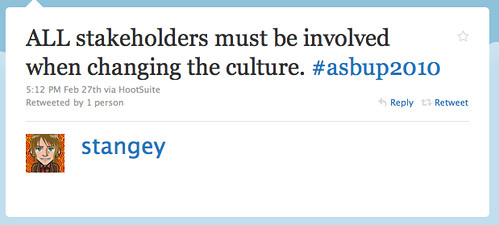


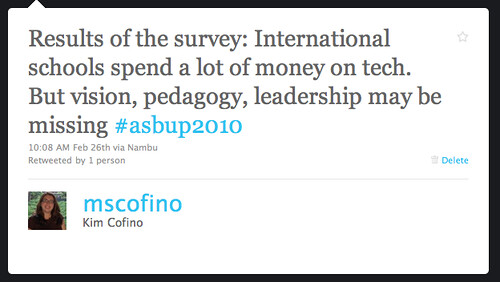
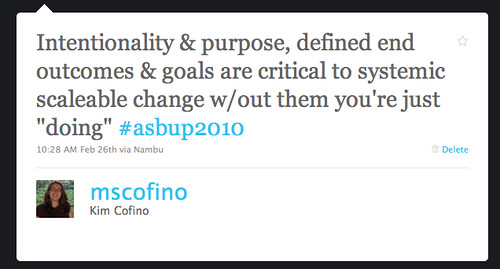
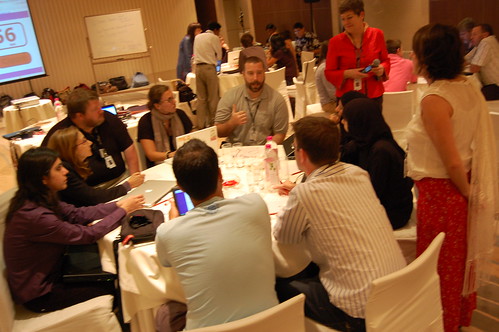

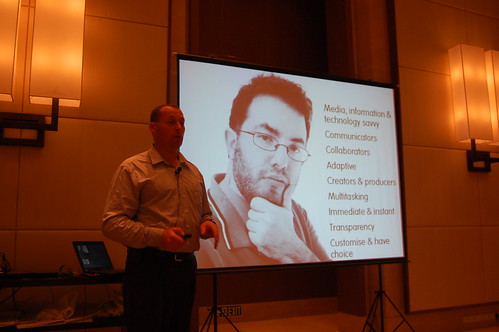


Kim, I enjoyed reading your thoughts from ASB Unplugged. Great stuff!
Plus you caught me in action doing our ‘Shock & Awe’ activity. Very cool.
It was wonderful to spend time with you in Mumbai. Looking forward to seeing you again soon!
Scott,
Thanks! It was so great to chat with you in Mumbai as well! Plus, I learned so much from your presentations.
This was great to read. Even though we are 10 years into our 1:1 program, we aren’t immune to the need to survey and communicate with our parents–every year it’s a new program to a number of families. We need to remember that what’s old hat to us is uncharted territory to them. We haven’t surveyed our parents for a few years specifically about the 1:1.
I also liked the student’s point that they are going to be facing online distractions for the rest of their lives, so it’s time to get used to them. Although I do feel we might be helping kids develop their problems solving skills with our filters :)
The fact that the students are not ready to go paperless yet interests me. I wish we had more research about how much paper we used pre-1:1, then again for the move to tablets.
Thanks Kim!
Sarah,
Wow! 10 years in, I’d love to hear your advice since we’re just getting started here. I do think the communication piece is critical – especially in international schools with the constant rotating enrollment and families (and teachers) coming from very different schools. I know, even though we’re not 1:1, there is so much technology here at ISB that is new to parents already – we’re definitely going to need to communicate even more once we get rolling next year! I loved the student presentation – they were so honest and everything they said was eye-opening. I wish I had been able to attend their other session…
Enjoyed reading this post. One of the essential conditions for a successful 1:1 program is to build tech leadership across all stakeholder groups. This goes along with your idea about involving all stakeholders. Without the leadership focus, there is always the danger of the involvement becoming superficial. Providing meaningful opportunities for leadership will help build ownership of the program within all stakeholder groups as well as embed tech integration. This becomes especially important in the transient population of our international schools. Too many good programs, initiatives, and ideas have short lives in our schools because of our moving populations. So the more one can do to move leadership out of the hands of the technology departments into the hands of stakeholders, the higher the chances of success of a 1:1 program.
Thanks so much for your thoughtful advice Shabbi. It was so clear from the conference that leadership is key – especially, as you say, with the transient population of international schools. It was wonderful to see just how many teachers, administrators and parents felt such ownership of the 1:1 program at ASB – it really was clear that it’s a community responsibility. Can’t wait to see what you do next!
I love the way you’re always able to condense and communicate the vast stream of information into really relevant points. Great job.
The things that resonate with me the most here are the importance of getting all stakeholder groups involved and giving people a chance to be heard. Even if what they have to say isn’t consistent with our goals as a school or modern pedagogy, we still need to illicit those responses or they’ll come back to poison the process.
I was also really moved by what the parents and students had to say. Totally agree that we are doing our students a disservice by “managing” their technology too much – they need to learn to deal with the distractions, but we need to teach them strategies to do this.
By creating information portals and confining their technology experiences to “walled gardens” we run the risk of controlling access to the information the same way we did in pre-guttenberg times. Technology used in this way doesn’t provide for a rich, student-centered, experience. Rather, it allows us to comfortably do things the way we’ve always done them with digital worksheets, information flowing from teacher to student, and interaction confined to the members of the class.
Jeff,
Yes, building understanding and ensuring community buy-in were clearly critical factors in ASBs success – something that could be so easily skipped in the process is rushed.
I totally agree with your statement: it allows us to comfortably do things the way we’ve always done them with digital worksheets, information flowing from teacher to student, and interaction confined to the members of the class. It can be so frustrating to see that cycle continue to perpetuate itself even with the variety of new ideas, methods, and tools we have at our fingertips. Changing mindsets is not so easy…
The first 1:1 program was made from slates and pieces of chalk – what a long way we’ve come since then. Yet schools are still afraid of this huge step to empower learners – you have laid down the steps that must be taken to ensure success and make everybody a stakeholder.
As usual your posting is clear, easy to read and contains all the sources needed to take it further. I do hope our schools will follow your pointers. Thank you!
Chris,
Why is it so challenging for schools to move to 1:1? I was just reading that it was recently the 20 year anniversary of the 1st 1:1 program. Twenty years! And we’re still questioning whether it’s a good idea or not. Not a swiftly moving field, is it?
Kim,
I think the reason that it is so challenging for schools to move to 1:1 is that all of the literature makes it a lengthy and costly task of re-inventing the school. Take a look at the list of things that need to be done. Reinvention is neither a short nor simple task as reinventing a school should not be. What schools do not ask is whether reinvention is now a necessary prerequisite for making such power available to students and teachers. In the past it certainly was necessary as the financial outlays (infrastructure, computers, software, training, support etc.) were large enough that they had to be closely examined. And the process of that examination opened up classroom practice for inspection by the community. The result, predictably, was a lengthy, sometimes contentious, process of examining teaching and learning in the school and determining future direction. As contentious as that process was in some schools, it did bring the community together.
But what if the financial commitment is not so large? What if the infrastructure of the school is in place? What if recent advances in cloud computing, open source, SAAS, and personal computing device ownership overcome the requirement that the school specify hardware and software? What if teachers are at the limit of what they can do sharing mobile labs? What if the goal is not to reinvent the school, but to get power into the students’ hands now knowing that with support and learning opportunities, teachers will continue to increase integration and effectiveness in their classrooms? Can you then shorten the process? In our case, we did: ten and a half school weeks from pilot proposal to the 1:1 pilot for sixth grade. A semester later we moved from pilot to full implementation in sixth and seventh grade where all students bring their own portable device.
We had read the research and reports and, because we had different initial conditions in our middle school, we deliberately chose to create a different path to implementation.
When we started our laptop program, we jumped in feet first with out real consideration of the depth of the water . The end result was for the first couple of years we were treading water, and even now 12 year down the track, I believe we are still playing catch up with some staff.
Fundemental to any program is the educational drivers or benefits – the What do we want our 1:1 program to achieve. This must be the starting place for any discussion. We can not have a laptop program that is in place because it looks good, to keep up with the school down the road or as a marketing tool. The goals must be to improve the education of our students.
Fortunately these goals are easy to see starting with preparing our students for a life with a increasingly digital content, to engage our students, to leverage the tools theya re using and by doing this engage and motivate, to provide access to tools that enhance learning, improve teaching etc.
Underlying all of these is a change in pedagogy, it is a shift from the stayed and traditional approaches to teaching and learning to, in my opinion, a more constructivist approach with an emphasis on higher order thinking skills, problem solving, real world contextual problems, timely and appropriate feedback etc. For me the constructivist approach inherent and core in project based learning is one of the key teaching techniques we can apply.
It is this change in pedagogy that is going to have the greatest effect and be the hardest to achieve, particularly when our school systems are underpinned by the need to achieve in an examination system focused on lower order thinking skills – namely the recollection and understanding of knowledge.
To have a successful program, in fact to successfully manage any change in schools you need to have 5 different factors need to be aligned to achieve any complex change. They are:
Vision – where are we going and what do we want to achieve
Skills – what are the skills both technical and pedagogical that we will need
Incentives – what will make the students abnd staff change
Resources – what do we need to provide to encourage, faciliate and enable this change
Action Plan – how are we going to do it and when
(thousand and Villa – managing complex change in schools)
Its a difficult process to undertake but the end point is a better place for our students.
Andrew,
Thank you so much for your thoughtful, detailed and practical advice. You have hit every major point I have been thinking about for the last few months. There are so many critical pieces we need to have in place (or at least address) before we move forward. I frequently reference your excellent summary of the Thousand and Villa article too – so clear and easy to understand the impact of change in schools. Thank you!
Kim-
Great job synthesizing the high points- I’ll be using your post to share with my Superintendent and School Board as a parent that is seeking local transformation to 1:1.
I also will share with state legislative leaders hoping we can muster a state initiative. Any recommendations for best place to go to get statistics/data on 1:1 in the U.S./globally?
Thanks Kim for the really insightful post.
Lisa
Lisa,
Thanks so much! Glad the post will be useful for you. I would highly recommend the AALF website for all sorts of research and data on 1:1 programs. Good luck!
Kim,
Amazing post! My school (International School of Helsinki) is in the process of proposing a 1:1 program. This information will be very useful as we move forward with this initiative.
I really agree about International Schools (and the education industry in general) spending heaps of money on hardware, but often overlook long-term vision, appropriate software, and training. In other industries they use the rule of thirds. Spend one third of your budget on hardware, one third on software, and one third on training.
Thanks for putting this together.
Alison,
Good luck with your 1:1 proposal! I love the rule of thirds – so simple and so important. Will keep that one in mind, especially as I transition to a new school (Yokohama International School, Japan) in August.
Glad the post was helpful!
Kim,
Thank you for sharing.
We will soon start our 1 to 1 tablet program. What would be the “four essential questions” you refer to in your post? (involve all stakeholders)
Any links to research that supports 1 to 1 iniatives?
Thanks.
Yolanda